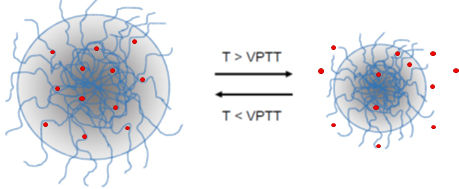
Thermoresponsive polymer microgels
Thermoresponsive polymers offer a wide range of possible applications for biocompatible drug delivery systems, microfluidic sensors or self-healing coatings. Homopolymers in solution as well as 3D-crosslinked microgel particles exhibit a sharp phase transition at the Volume Phase Transition Temperature (VPTT). Above the VPTT a swollen microgel collapses into a solid particle, allowing structural control by temperature variation in these systems. However, for drug delivery applications the influence of small molecules on the phase transition is a critical issue, as it may shift or broaden the transition. We investigate the effects of small aromatic model drugs as additives on the phase transition, employing on the one hand different NMR methods, which characterize polymer as well as additive dynamics and thus elucidate the additive localization and distribution in microgel dispersions (see Figure). On the other hand we showed that Isothermal Titration Calorimetry (ITC) is a suitable method to study mutual drug-polymer influences, as it delivers a critical additive concentration of polymer collapse.
Currently the project aims at the formation and study of more complex microgel structures (e.g. core-shell structures) and their benefits concerning model drug localization and dynamics. In particular, we are investigating the influence of different isomers of small aromatic additives on the phase transition and we clarify local additive dynamics in the presence of microgels.

